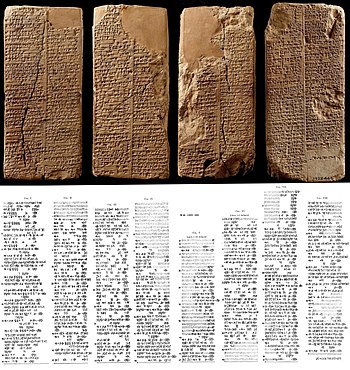
Back የሱመራውያን ነገሥታት ዝርዝር Amharic قائمة ملوك سومر Arabic Шумер һәм Аккад батшалары исемлеге Bashkir Списък на царете на Шумер и Акад Bulgarian Sumerski spisak kraljeva BS Llista de reis sumeris Catalan Sumerský královský seznam Czech Sumeriske kongeliste Danish Sumerische Königsliste German Lista Real Sumeria Spanish
 The Sumerian King List inscribed onto the Weld-Blundell Prism, with transcription. | |
| Original title | 𒉆𒈗 (Nam-Lugal "Kingship").[1] |
|---|---|
| Translator | |
| Language | Sumerian |
| Subject | Regnal list |
| Genre | Literary |
| Set in | Late-third to early-second millennia BC (c. 2900 – c. 1792 BC) |
Publication date | Ur III to Old Babylonian periods (c. 2084 – c. 1648 BC) |
| Publication place | Sumer (ancient Iraq) |
Published in English | AD 1911–2014 |
| Media type | Clay tablets |
| Text | Sumerian King List at the Electronic Text Corpus of Sumerian Literature |
The Sumerian King List (abbreviated SKL) or Chronicle of the One Monarchy is an ancient literary composition written in Sumerian that was likely created and redacted to legitimize the claims to power of various city-states and kingdoms in southern Mesopotamia during the late third and early second millennium BC.[2][3][4] It does so by repetitively listing Sumerian cities, the kings that ruled there, and the lengths of their reigns. Especially in the early part of the list, these reigns often span thousands of years. In the oldest known version, dated to the Ur III period (c. 2112 – c. 2004 BC) but probably based on Akkadian source material, the SKL reflected a more linear transition of power from Kish, the first city to receive kingship, to Akkad. In later versions from the Old Babylonian period, the list consisted of a large number of cities between which kingship was transferred, reflecting a more cyclical view of how kingship came to a city, only to be inevitably replaced by the next. In its best-known and best-preserved version, as recorded on the Weld-Blundell Prism, the SKL begins with a number of antediluvian kings, who ruled before a flood swept over the land, after which kingship went to Kish. It ends with a dynasty from Isin (early second millennium BC), which is well-known from other contemporary sources.
The SKL is preserved in several versions, the first fragement of which was published in 1906 by Hermann Volrath Hilprecht, and the second in 1911 by Jean-Vincent Scheil.[5] Most of these date to the Old Babylonian period, but the oldest version of the SKL dates back to the Ur III period. The clay tablets on which the SKL was recorded were generally found on sites in southern Mesopotamia. These versions differ in their exact content; some sections are missing, others are arranged in a different order, names of kings may be absent or the lengths of their reigns may vary. These differences are both the result of copying errors, and of deliberate editorial decisions to change the text to fit current needs.
In the past, the Sumerian King List was considered as an invaluable source for the reconstruction of the political history of Early Dynastic Mesopotamia. More recent research has indicated that the use of the SKL is fraught with difficulties, and that it should only be used with caution, if at all, in the study of ancient Mesopotamia during the third and early second millennium BC.
- ^ Mesopotamia: The World's Earliest Civilization. Britannica Educational Publishing. 1 April 2010. p. 45. ISBN 978-1-61530-208-6.
- ^ Cite error: The named reference
:9was invoked but never defined (see the help page). - ^ Cite error: The named reference
:12was invoked but never defined (see the help page). - ^ Cite error: The named reference
:11was invoked but never defined (see the help page). - ^ Cite error: The named reference
:8was invoked but never defined (see the help page).